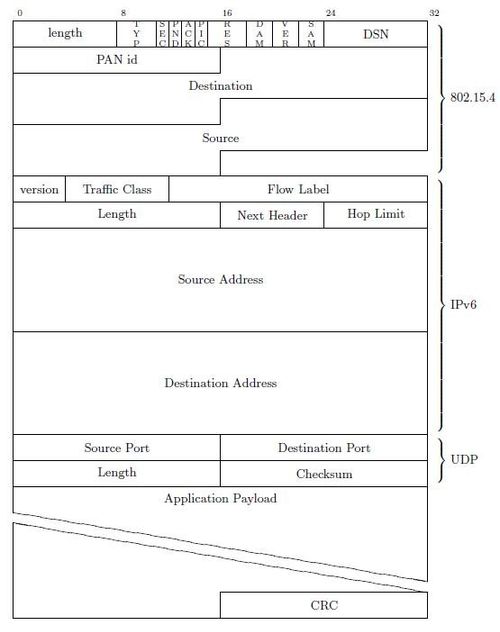...
Let's assume the simplest case of a point-to-point link in a wireless multi-hop network network (which is also the best case for 6LoWPAN). The figure below depicts the IEEE802.15.4, IPv6 and UDP headers commonly found in a packet. Alliances such as IP for Smart Objects (http://www.ipso-alliance.org/) provide a clear indication that this type of standard packet structure will become ubiquitous in tomorrow's networks of resource-constrained wireless devices.
RFC4944
6LoWPAN removes a number of fields in the IPv6 and UDP headers because they take well-known values, or because they can be inferred from fields in the IEEE802.15.4 header. In the IPv6 header, the version field is always 6 for IPv6, the traffic class and flow label are never used, the length field is always equal to the length field of IEEE802.15.4 minus the length of the IPv6 header. All these fields can hence be removed. Because Next Header typically point to either UDP or TCP, this 8-bit field can be replace by a 2-bit field as part of the the HC1 field of the 6LoWPAN header. Finally, RFC2464 defines how 128-bit IPv6 addresses can be recovered from 64-bit MAC addresses, such as the IEEE802.15.4's Source and Destination fields. This removes the IPv6 Source Address and Destination Address fields. In the end, only the Hop Limit field needs to be present in the 6LoWPAN header. Similarly for UDP, the Length can be calculated from the IEEE802.1.54's Length field; in the most common case, only a limited number of ports with be used, so 4-bits can be used to describe them, rather than 8 bit. The figure below shows the same packet as above, compressed using 6LoWPAN.
IPHC
RFC4944 is insufficient for most practical uses of 6LoWPAN networks. It is most effective for link-local unicast communication, where IPv6 addresses carry the link-local prefix and an Interface Identifier (IID) directly derived from IEEE802.15.4 addresses. In this case, both addresses may be completely elided. However, link-local addresses are usually not used for application-layer data traffic, so the actual value of this compression mechanism is limited.
...



